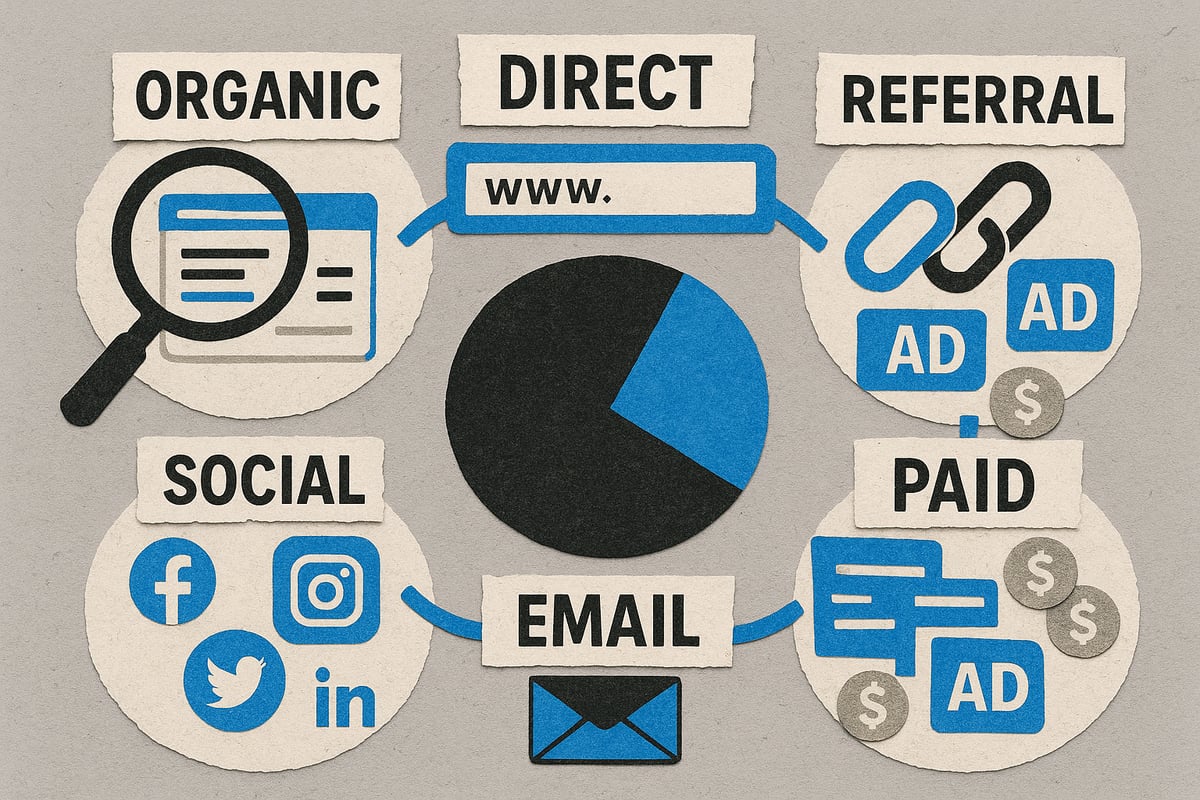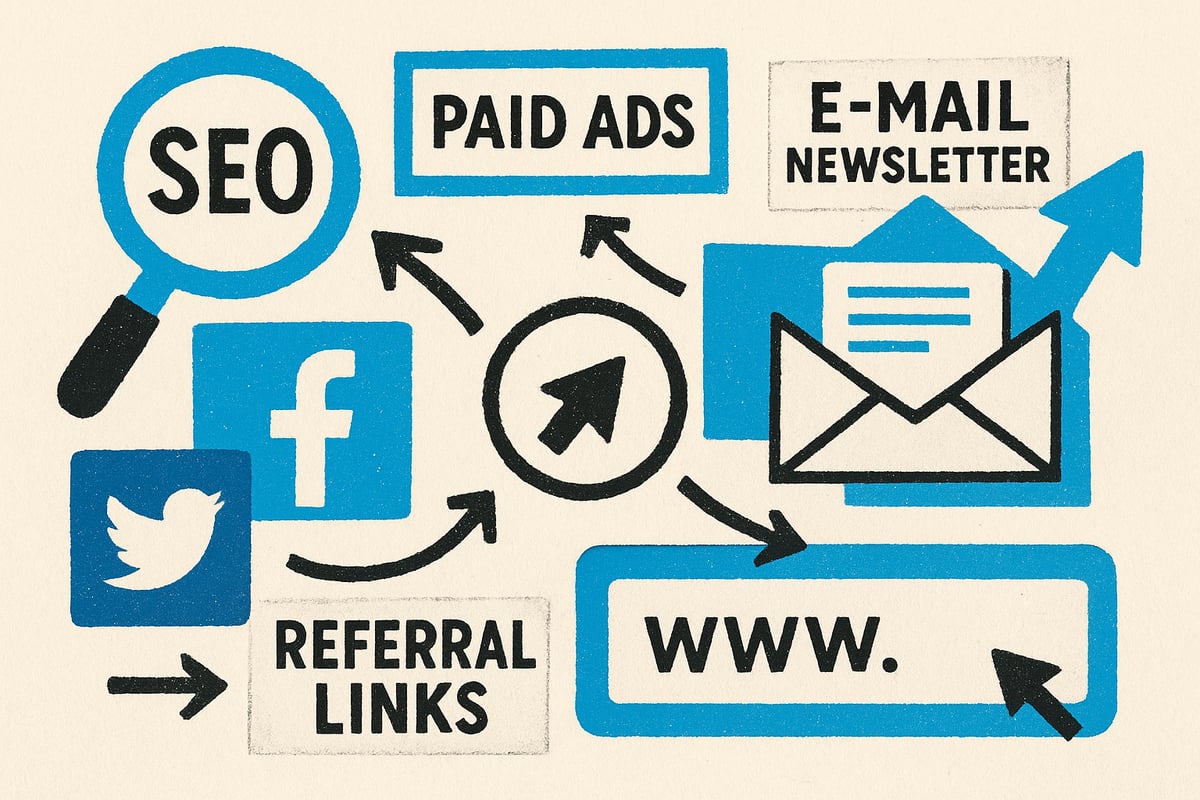- Date
Website Traffic Sources Guide: Master Your Growth in 2025
 Andrii Romasiun
Andrii Romasiun
The race for website growth in 2025 is more intense than ever. With digital competition at an all-time high, understanding where your visitors originate is no longer optional—it is essential for survival.
Most websites fail to reach their potential because they lack clarity on their website traffic sources. Without this insight, growth stalls, marketing budgets are wasted, and opportunities slip away.
Mastering website traffic sources unlocks steady growth, higher ROI, and smarter marketing decisions. This guide promises actionable strategies, expert analysis, and a complete breakdown of every major source driving visitors to your site.
You will learn how to identify, measure, and optimize each channel for sustainable success. Explore the six primary traffic sources, analytics best practices, optimization methods, and emerging trends set to define 2025.
Ready to transform your approach and achieve lasting website growth? Let us begin.
The 6 Core Website Traffic Sources Explained
Understanding the six core website traffic sources is essential for building a data-driven growth strategy in 2025. Each source offers unique opportunities and challenges, influencing how visitors find and interact with your site.

Organic Search Traffic
Organic search is one of the most powerful website traffic sources, driving visitors through unpaid search engine results. According to Website Traffic Statistics 2025, organic search accounts for over half of all web traffic, making it vital for sustainable growth.
To capture this audience, focus on keyword optimization, high-quality content, and technical SEO. Most users skip ads and trust organic listings, leading to higher engagement rates. However, evolving search engine results pages, AI overviews, and featured snippets are reducing click-through rates. For example, a well-optimized service page can consistently attract leads, but ongoing updates are crucial as search algorithms shift.
Direct Traffic
Direct traffic is another key player among website traffic sources. These visitors type your URL directly or use bookmarks, reflecting strong brand recognition and loyalty.
Direct traffic can sometimes be inflated by internal employee visits, so filtering your analytics is important for accurate measurement. Additionally, some direct visits may originate from untracked shares on messaging apps or email, known as "dark social." For established brands, direct traffic often forms a significant portion of overall website visits, highlighting trust and repeat engagement.
Referral Traffic
Referral traffic is generated when users arrive via links from other sites, making it a valuable segment among website traffic sources. High-quality referrals not only boost visits but also improve your site's authority and SEO.
Effective strategies for growing referral traffic include guest blogging, influencer outreach, and converting brand mentions into backlinks. The quality of referring domains matters more than quantity, so focus on reputable sources. For instance, a guest post on a leading industry blog can drive targeted, high-value visitors. While referral traffic may be smaller in volume, its impact on credibility and conversions is often substantial.
Paid Traffic
Paid traffic is one of the fastest website traffic sources for driving new visitors. This includes clicks from PPC ads, display banners, and paid social campaigns.
Paid campaigns offer precise targeting based on audience intent and demographics. However, results stop when your budget does, so ongoing investment and ROI tracking are critical. Types of paid traffic include search ads, social ads, and retargeting. For example, a Google Ads campaign can rapidly boost product awareness, but costs must be managed carefully. Paid search contributes a notable share of total website visits, supporting both short-term and long-term marketing goals.
Email Marketing Traffic
Email marketing traffic is a highly controllable source, as you own your list and messaging. Campaigns and newsletters can deliver steady spikes in visits, nurture leads, and drive repeat engagement.
Best practices include segmenting your audience and using UTM parameters to track results accurately. For example, a weekly newsletter that highlights new content can generate consistent, high-engagement sessions. Email remains one of the highest-ROI digital channels, making it indispensable for retention and growth.
Social Media Traffic
Social media traffic originates from platforms like Facebook, LinkedIn, and Twitter. Its scalability depends on your audience size and engagement levels.
Both organic and paid social posts can drive visitors, but the impact varies by industry and platform. Some social traffic is underreported due to dark social sharing. For instance, a viral Twitter post can generate a sudden spike in visits. While social media currently delivers a smaller share of total website traffic, it is vital for brand awareness and community building.
Understanding and Measuring Traffic Sources in 2025
Staying ahead in digital marketing means mastering how to analyze and interpret website traffic sources. In 2025, the landscape is evolving quickly. Knowing exactly where your visitors originate is crucial for growth, accurate attribution, and effective strategy.
The Evolution of Analytics Tools
The shift from Universal Analytics to GA4 and privacy-first platforms is changing how businesses measure website traffic sources. GA4 now groups channels differently, offering 18 default channel groups for nuanced attribution. However, challenges like dark social, cross-device journeys, and zero-click searches make tracking more complex.
To get started, marketers must focus on accurate channel grouping, session attribution, and clean data. For a step-by-step guide on tracking and analyzing various website traffic sources, see the Guide to tracking website traffic.
Privacy, Compliance, and User Trust
Privacy regulations such as GDPR and CCPA are reshaping data collection for website traffic sources. Users today expect transparency and control over their information. The rise of cookieless tracking and consent-free analytics means less granular data, but more ethical practices.
As third-party cookies disappear, more sites are adopting privacy-first tools. This shift not only builds user trust but also ensures compliance, which is now a foundational part of digital analytics. Many users are rejecting cookies or using privacy tools, further emphasizing the need for compliant solutions.
Key Metrics for Each Traffic Source
Measuring website traffic sources requires tracking the right metrics. Core indicators include:
- Sessions and users per channel
- Bounce rate and average session duration
- Conversion rate by traffic source
- Multi-touch attribution for ROI
Channel-specific KPIs matter too. For example, organic search focuses on keyword rankings, while paid channels emphasize ad cost and return. Comparing engagement metrics across website traffic sources reveals where to optimize. Engagement and conversion rates will always vary by channel, so benchmarking is essential.
Common Analytics Pitfalls and How to Avoid Them
When analyzing website traffic sources, common pitfalls can distort your data:
- Misattribution: Branded searches may appear as direct or organic.
- Internal traffic: Forgetting to filter out employee visits skews numbers.
- UTM misuse: Inconsistent tagging leads to data gaps.
- Dark social: Shares without tracking parameters show up as direct traffic.
To avoid these issues, regularly audit your analytics setup. Consistent use of UTM parameters and proper filtering are critical for accurate insights into your website traffic sources.
Swetrix: Privacy-Focused Analytics for Modern Marketers
Swetrix is a GDPR-compliant, cookieless analytics platform designed for modern marketers focused on website traffic sources. It provides anonymous tracking, real-time dashboards, and full data ownership, all without cookie banners.

Swetrix excels at measuring every website traffic source while prioritizing user privacy. Features include detailed source breakdowns, error monitoring, and customizable alerts. For organizations needing both actionable insights and compliance, Swetrix offers a future-proof solution that covers referral, organic, direct, and campaign traffic with confidence.
Strategies to Optimize Each Traffic Source for Growth
Unlocking the full potential of your website traffic sources requires a tailored strategy for each channel. By optimizing every source, you can achieve sustainable growth, maximize ROI, and future-proof your online presence. Let’s break down proven tactics for every major traffic stream in 2025.

Organic Search Optimization
Organic search is the backbone of most website traffic sources. To stand out, focus on advanced SEO tactics that address evolving algorithms and user intent. Start by targeting long-tail and commercial intent keywords that match what your audience is searching for.
Regularly update and expand your content to ensure depth, authority, and relevance. Refresh outdated pages, add FAQs, and optimize for featured snippets. Technical SEO is equally important—boost site speed, mobile usability, and indexability to improve rankings.
Embrace the changes brought by AI and new SERP features. Structure content for AI overviews, voice search, and answer boxes. Prioritize backlink acquisition from high-quality domains to strengthen authority. For example, updating your service pages can help maintain visibility as SERPs evolve. With organic click-through rates declining, optimizing your approach to website traffic sources is more critical than ever.
Paid Traffic Campaigns
Paid traffic offers rapid growth opportunities among your website traffic sources. Start by selecting the right channel—paid search, display, or paid social—based on your business goals and audience.
Use precise targeting options, including demographics, behavior, and intent, to reach high-value prospects. Carefully manage your budget by monitoring cost-per-click and conversion rates. Creative testing is essential: run A/B tests on ad copy, visuals, and landing pages to identify what resonates best.
Implement retargeting campaigns to re-engage visitors who didn't convert initially. For example, leverage your best-performing organic content as the foundation for paid campaigns. Remember, paid channels can deliver quick wins but require ongoing investment and optimization across all website traffic sources.
Referral and Backlink Growth
Referral traffic is a high-value segment within your website traffic sources, driven by authoritative backlinks and strategic partnerships. Begin by identifying relevant industry sites and conducting targeted outreach for quality backlinks.
Build partnerships for content sharing and reciprocal promotion. Secure PR placements and reviews on trusted platforms to boost credibility. Guest posting on reputable blogs establishes authority and drives targeted referral visits.
Monitor your backlink profile using analytics tools to track new and lost links. Turning unlinked brand mentions into referral links is a powerful tactic. Remember, referral traffic not only brings engaged users but also strengthens your domain authority, making it a vital component of your website traffic sources strategy.
Email Marketing Optimization
Email remains one of the most consistent website traffic sources for driving repeat visits and engagement. Segment your email list to personalize content and increase relevance for different audience groups.
Set up automated drip campaigns and transactional emails to nurture leads. Test subject lines to boost open rates, and optimize calls to action for higher click-throughs. Use UTM parameters to track campaign performance accurately—see this guide on using UTM parameters for tracking to ensure you are attributing traffic to the right sources.
Regular analytics reviews allow you to refine your strategy based on open, click, and conversion rates. For example, A/B testing different email layouts can significantly increase engagement from this essential segment of your website traffic sources.
Social Media Engagement
Social media can be unpredictable, but it remains vital among website traffic sources for brand awareness and reach. Develop a content strategy that balances evergreen posts, trending topics, and interactive content to foster engagement.
Prioritize platforms that align with your target audience, such as LinkedIn for B2B or Instagram for B2C. Maintain a consistent posting schedule to build momentum. Collaborate with influencers and industry voices to expand your reach and credibility.
Invest time in community building by responding to comments and participating in conversations. Campaigns like a LinkedIn lead generation series can drive measurable results. While social media traffic may fluctuate, it plays a key role in strengthening your overall website traffic sources portfolio.
Direct Traffic & Brand Building
Direct traffic reflects the strength of your brand within your website traffic sources. Invest in memorable branding, consistent messaging, and positive user experiences to encourage repeat visits.
Promote your website offline through events, print materials, and word-of-mouth to generate more direct entries. Encourage bookmarking and ensure your site ranks at the top for branded searches. Running branded campaigns can increase direct visits and reinforce loyalty.
Strong brands naturally see a higher share of direct traffic and improved conversion rates. By nurturing brand recognition, you create a resilient foundation for all your website traffic sources.
Future Trends: How Website Traffic Sources Will Evolve in 2025
The landscape of website traffic sources is rapidly evolving, shaped by new technology, user expectations, and regulatory changes. Understanding these trends is essential for marketers who want to stay ahead and ensure sustainable growth. Let us explore the key shifts that will define success in 2025.

AI and Zero-Click Search
AI is revolutionizing how people interact with search engines. Increasingly, users get answers directly on the search results page, reducing the need to click through to websites. This trend, known as zero-click search, is reshaping website traffic sources. For example, Google’s AI-generated overviews and featured snippets now occupy prime real estate, influencing which sites receive traffic.
According to Web Traffic Share by Channel 2025, organic search remains dominant, but the share of zero-click results is rising every year. To adapt, businesses must structure content for snippets, voice assistants, and conversational AI. Optimizing for visibility within these AI-driven features will be critical for maintaining a strong presence among all website traffic sources.
Privacy-First Web Analytics
Privacy concerns are transforming how marketers measure website traffic sources. With regulations like GDPR and the phasing out of third-party cookies, the industry is moving toward ethical, consent-free analytics. This shift affects attribution, making data less granular but more trustworthy.
Modern tools now focus on user trust and compliance, offering solutions that respect privacy while still delivering actionable insights. For a deeper dive into these approaches, see Privacy-friendly website analytics. By adopting privacy-first platforms, businesses can accurately track website traffic sources without compromising user trust or facing regulatory risks.
Social Media Platform Shifts
Social media is no longer limited to a handful of dominant platforms. In 2025, website traffic sources from social are diversifying, as users migrate to niche communities and private networks. New platforms with unique algorithms are changing how brands reach and engage audiences.
Marketers must monitor where their audiences are most active and adapt quickly. This means experimenting with emerging platforms and tailoring content for different social environments. Understanding these shifts ensures your strategy captures the full spectrum of website traffic sources, even as user preferences evolve.
Multi-Channel Attribution and AI-Powered Insights
Attribution models are becoming smarter and more integrated, thanks to AI. In 2025, businesses will use AI-driven tools to analyze customer journeys across multiple website traffic sources. This enables more accurate ROI tracking and reveals which combinations of channels drive conversions.
By integrating data from various platforms, marketers gain holistic insights that inform smarter decisions. For example, AI can identify high-value paths that users take from social to email to direct visits. Embracing these advanced attribution models will be essential for optimizing all website traffic sources and unlocking sustainable growth.
Evolving User Behavior and Expectations
User expectations are rising, and so is the demand for privacy, speed, and seamless experiences. Many people now use ad blockers, privacy tools, and mobile devices as their primary way to access the web. These changes impact how website traffic sources perform and how marketers should respond.
Sites that prioritize privacy, fast loading times, and cross-device usability will attract and retain more visitors from every channel. Meeting evolving expectations is not optional, it is essential for capturing and maximizing website traffic sources in 2025 and beyond.
Action Plan: Steps to Master Website Traffic Sources in 2025
Ready to take control of your website growth? The following action plan breaks down proven steps to help you master website traffic sources in 2025. Each step is designed to build on the last, providing clarity, focus, and measurable results. Let’s dive in.
Step 1: Audit Your Current Traffic Sources
Begin by conducting a thorough audit of your website traffic sources. Use analytics platforms to break down traffic by channel, such as organic, direct, referral, paid, email, and social. For a refresher on tracking fundamentals, check out Understanding web analytics basics.
Filter out internal visits and bot activity to ensure your data is accurate. Benchmark your current results against industry standards, referencing resources like Website Statistics 2025: Key Stats and Data for context. Most sites rely heavily on one or two channels, but identifying underutilized website traffic sources can unlock new growth opportunities.
- Review analytics dashboards for channel breakdowns.
- Apply filters for clean, reliable data.
- Compare your performance to industry benchmarks.
Step 2: Set Clear Goals for Each Channel
Next, define specific KPIs for all website traffic sources. Align these goals with your broader business objectives, such as increasing organic leads, boosting email engagement, or improving paid ad ROI.
For example, you might set a goal to increase organic traffic by 20 percent within six months or to double referral visits from high-authority sites. Use industry data to set realistic targets, drawing insights from resources like Website Statistics 2025. Goal-oriented strategies lead to more focused execution and measurable progress.
- Establish unique KPIs for each channel.
- Connect channel goals to business impact.
- Use current analytics to inform targets.
Step 3: Implement Tracking and Attribution Best Practices
Accurate tracking is essential for understanding the effectiveness of your website traffic sources. Apply UTM parameters to every campaign, ensuring each source is precisely attributed. Regularly audit your analytics setup to catch inconsistencies or misattributions.
Integrate privacy-focused analytics solutions to comply with evolving regulations. Whether you use GA4 or a privacy-first tool, precise tracking allows you to see which website traffic sources deliver the best results.
- Standardize UTM tagging for all campaigns.
- Routinely review analytics configurations.
- Prioritize privacy compliance in tracking.
Step 4: Optimize Channel Performance with Targeted Strategies
Now, focus on optimizing each channel using tailored strategies. Leverage SEO for organic, refine ad targeting for paid, and personalize content for email. Prioritize channels that consistently perform well, but do not ignore emerging opportunities.
Shift resources from underperforming channels to high-ROI website traffic sources. Quick wins, such as updating top content or retargeting visitors, can drive immediate improvements. Continuous optimization ensures your strategy remains adaptable and effective.
- Apply channel-specific optimization tactics.
- Focus on both quick wins and long-term gains.
- Reallocate budget based on ROI data.
Step 5: Test, Analyze, and Iterate
Testing is the engine of growth for website traffic sources. Run A/B tests on landing pages, ads, and email campaigns to see what resonates. Analyze the results, then iterate on your approach to maximize performance.
Foster a culture of experimentation within your team. The most successful sites are those that treat every initiative as a learning opportunity. With ongoing testing, you can refine your approach to each website traffic source for sustained gains.
- Conduct regular A/B and multivariate tests.
- Document learnings from each experiment.
- Adjust strategies based on real data.
Step 6: Stay Ahead of Trends and Evolving User Expectations
Keep a close watch on industry news and algorithm updates that affect website traffic sources. Invest in analytics and marketing tools that are privacy-first and future-proof. Adapt quickly to shifts in user behavior, such as increased mobile usage or demand for privacy.
Early adoption of new technologies, like AI-driven analytics or emerging social platforms, can provide a significant competitive edge. Staying proactive ensures your website traffic sources remain robust as digital landscapes evolve.
- Monitor digital marketing trends and updates.
- Upgrade tools to meet privacy and compliance needs.
- Respond quickly to changes in user expectations.
Step 7: Foster Cross-Channel Synergy
Finally, integrate your marketing efforts across all website traffic sources for maximum impact. Create campaigns that move users between channels, such as combining email with social retargeting or linking organic content to paid ads.
Align messaging and branding for a seamless user experience. Cross-channel strategies deliver higher conversion rates and help you make the most of every website traffic source.
- Coordinate campaigns across multiple channels.
- Use retargeting to guide users through their journey.
- Maintain consistent messaging and visual identity.
Ready to take control of your website’s growth in 2025? Understanding where your visitors come from is crucial, and you deserve analytics that are both insightful and privacy-first. Throughout this guide, we’ve explored actionable strategies for every major traffic source and highlighted best practices for tracking and optimization. If you want to turn those insights into real, measurable progress—without sacrificing user trust or getting bogged down by cookie banners — I encourage you to Try Swetrix today. It’s a straightforward, GDPR-compliant way to unlock your site’s true potential and master your growth journey.